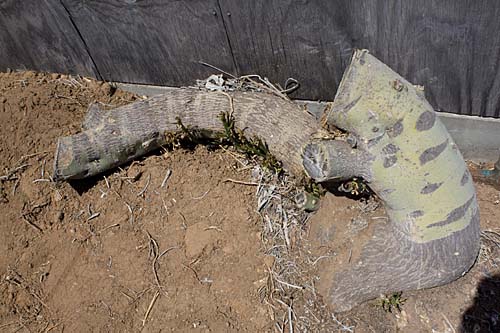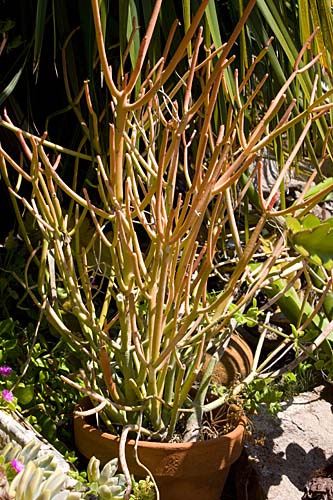I’ve killed my share of plants when my pride in being able grow something got in the way of common sense. And then there are cases where the plant gets the serious upper hand.
One example of the second situation is of a pencil cactus, Euphorbia tirucalli. (Notwithstanding its common name it’s not a cactus at all, and instead belongs to the genus that brings you the perky holiday poinsettia.)
Someone gave John a little cutting. It looked cute. Why not put it in the ground? A little bush with pencil-shaped leaves would be fun.
Several years later its cuteness wore off as it matured into a serious large shrub, ten feet tall. At some point John tried to prune it and got some sap into his eye. There are reports of temporary blindness for at least three days as a result of the sap, in addition to frequent reports of extreme skin irritation. Fortunately John’s situation wasn’t so dire, but it was extremely painful. That wiped out almost all of the plant’s cuteness points, and when its roots started to push over a retaining wall, that was it. It had to go.
I tend to be generous in my evaluations of the value of various plants. There are specific niches in specific ecosystems for every species. When pulled out of an appropriate context and thrown into an grossly inappropriate one, however, plants can respond in two ways. Either they can die–not good for the plant. Or they can take over the way this euphorbia did–not good for the new environment or growing situation.
Last Fall I got out the pruners, loppers and ax, covered every bit of exposed skin that I could, then started to take the thing down. The plant easily filled up the back of the pickup with wet succulent plant parts oozing sticky, milky juices.
The local landfill has a greens recycling program. But they took one look at the evil load and directed us to the dump side of the facility. As a result, a couple millennia down the road, some archaeologist will try to make sense of our culture by picking through a pile of broken washing machines, rotted sofas, discolored pizza boxes and pieces of a mysterious plant with powers to blind and incapacitate.

Nine months later the plant is seriously set back, though not entirely dead. My energy flagged before I could get the stump out of the ground, and every now and then the plant tries to come back to life. I’ve since seen shade-tree sized specimens of the species in West Hollywood, so I’m convinced I got to the plant before it was too late. I’ll just keep at the regrowth until the plant decides to give up the ghost.
 Halfway across the yard, in a little clay pot, sits another variant of this species, the red form that’s been given the clonal name ‘Rosea,’ and is commonly known as “sticks of fire.” It’s supposed to be a lot less vigorous. It’s not supposed to get much over six feet tall. It’s supposed to lack the same amount of chlorophyll and have less of that life force than its green big brother. But I’m skeptical. That plant isn’t going to get to live outside of its pot. Ever.
Halfway across the yard, in a little clay pot, sits another variant of this species, the red form that’s been given the clonal name ‘Rosea,’ and is commonly known as “sticks of fire.” It’s supposed to be a lot less vigorous. It’s not supposed to get much over six feet tall. It’s supposed to lack the same amount of chlorophyll and have less of that life force than its green big brother. But I’m skeptical. That plant isn’t going to get to live outside of its pot. Ever.
Talking to one of the members of the local cactus and succulent society, he thought that was for the best. The red variant hasn’t been around for more than a few years. No one knows its possible eventual size. As far as its eventual supposed six foot height? “I’d be very skeptical,” he said.
Behind him, planted in the ground just a few dozen yards away, was one of the red forms of the plant. It was already five feet tall.
